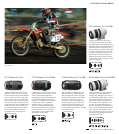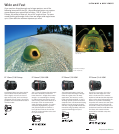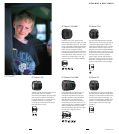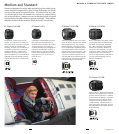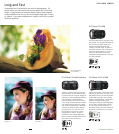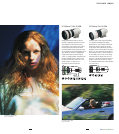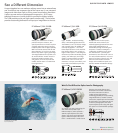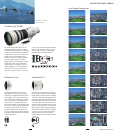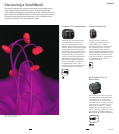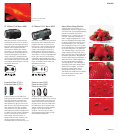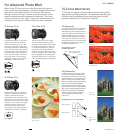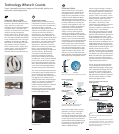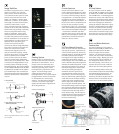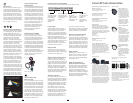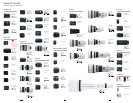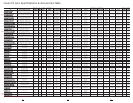
Image Stabilizer
No matter how great the lensis, camera
shake can spoil the shot. Blurred
photos due to camera shake usually
occur when the shutter speed isslower
than the reciprocalof the lens focal
length. For example, a shutter speed
slower than 1/200 sec. at the 200mm
focal length can invite a blurred photo
caused by camera shake. In such
cases, a tripod is necessary. However,
a tripod can be a heavy and troublesome
burden when you go hiking or traveling.
There are even places where using
tripods is prohibited. Using a slow
shutter speed then becomes difficult.
To resolve this problem, Canon became
the first manufacturer to incorporate an
Image Stabilizer in an SLR camera lens.
Optical shake is detected bygyro
sensors which provide the data
necessary to shift the image-stabilizing
lens group in parallel to neutralize the
shake. This increases the usable
shutter speed range by up to 2 full
steps for hand-held shooting. Except
for the EF 28-135mm f/3.5-5.6 IS USM
and EF 75-300mm f/4-5.6 IS USM
lenses, IS lenseshave two IS modes.
One is for normalimage stabilization
and the other is for panned shots. With
a monopod, the Image Stabilizer on all
IS lenses operates normally as during
hand-held shooting. Also, the EF300mm
f/2.8L ISUSM, EF 400mm f/2.8L ISUSM,
EF 500mm f/4L ISUSM, and EF 600mm
f/4L ISUSM lenses have a mechanism
that prevents having the Image Stabilizer
turned on while the lens is mounted on
a tripod.
Floating System
Ordinary lenses are designed to give
the best resultswhen the correction of
aberrations is most effective. This is
usually at the most commonly-used
focusing distances. At other focusing
distances, especially at the closest
focusing distance, aberrations tend to
appear. Canon’s floating system
suppresses aberrations at close
focusing distances. This system adjusts
the gap between certain lenselements
in correspondence to the focusing
distance. The aberration is effectively
corrected. The result ishigh image
quality with aberrations suppressed at
all focusing distances.
37
36
Circular Aperture
Certain Canon lenses feature a new
Circular Aperture diaphragm unit, which
uses curved aperture blades to provide
for a more rounded opening as the lens
is stopped down. It’s especially effective
at rendering out-of-focusbackground
highlights asnatural rounded shapes. In
lenses such as the EF 70-200mm f/2.8L
IS lens, the lens opening is virtually
circular from f/2.8 to f/5.6. These lenses
retain all the benefits previously available
with Canon’s Electromagnetic Diaphragm
—smooth and consistent stop-down
operation (even at up to 10 fpswith the
EOS-1v), near-silent aperture control, and
total absence ofmechanical leversor
switches in the lens mount.
1: No camera shake
2: Lens front shakes downward
3: Image-stabilizing group counteracting
downward camera shake
Group 1 (focusing group)
Group 2 (image-stabilizing group)
To
Object Group 3 to 6
Film
plane
Direction of Group 2
movement
How the Image Stabilizer Works in the EF 75-300mm
f/4-5.6 IS USM
Astigmatism
Floating Effect (TS-E 24mm f/3.5L)
Floating System
Closest
shooting
distance
TS-E 24mm f/3.5L Floating System
Floating
Film plane
With Image
Stabilizer on
With Image
Stabilizer off
AF Stop Feature
AF stop is featured on the EF 300mm
f/2.8L ISUSM, EF 400mm f/2.8L ISUSM,
EF 500mm f/4L ISUSM, and EF 600mm
f/4L ISUSM lenses. If something passes
between the camera and subject during
autofocusing, pressing the AF stop buttons
momentarily locks the AF to preventthe
focus from shifting to the obstruction
passing by. After the obstruction is gone,
the focus is still maintained on the subject
and you can quicklyresume shooting.
The AF stop buttons are positioned at
four locations around the lens grip at the
front of the lens for easy accessduring
both horizontal and vertical shooting.
Dust- and Water-Resistant
Construction
The new EF 300mm f/2.8L ISUSM, EF
400mm f/2.8L ISUSM, EF 500mm f/4L IS
USM, and EF 600mm f/4LIS USM
lenses are highly dust- and water-
resistant. The switch panel, exterior
seams, and drop-in filter compartment
have rubber linings. Moving parts such
as the focusing ring and switches are
also designed to prevent water and
dust from entering. These lensescan
therefore be used in harsh conditions
without dust and water getting inside.
The lens isequipped with a rubber ring
on the mount to improve itsdustproofing
and waterproofing characteristics. As
the lens is repeatedly mounted and
detached, the rubber ring will leave fine
abrasion marks on the outside of the
camera mount. This will not affectoperation.
Full-Time Manual Focusing
Canon EF lenses and EOS cameras have
very high AF precision. Optimum focus
can be achieved quicklyfor almost any
shooting situation. Recent EOS cameras
have been equipped with multiple
focusing points for higher flexibility in
composing a photo while using AF.
Picture-taking iseven more flexible with
Canon’sfull-time manual focusing which
overrides the autofocusing mode. Lenses
with this feature allow you to switch to
manual focusing even in the AF mode.
You can keep looking through the
viewfinder and touch up the focus
manually without switching the focus
mode switch. Since the focusing ring
does not rotate during autofocusing, we
could make it wider for better holding
comfort and easier manual focusing.
Another ergonomic design which lets
you convey your intentionsquickly. Full-
time manual focusing comes in two types.
One is electronic manualfocusing where
the rotation amount of the focusing ring
is detected and the focusing motor is
driven electronically. The other type is
mechanical manual focusing where the
rotation of the focusing ring adjusts
the focus mechanically.
Manual focus ring
Focus key
Ring 1
RollerRoller Rotor
Stator
Pressing spring
USM Unit
Focusing unitFocusing lens group
Ring 2
Input pulse board
for electronic manual
focusing
Full-time mechanical manual focusmechanism



